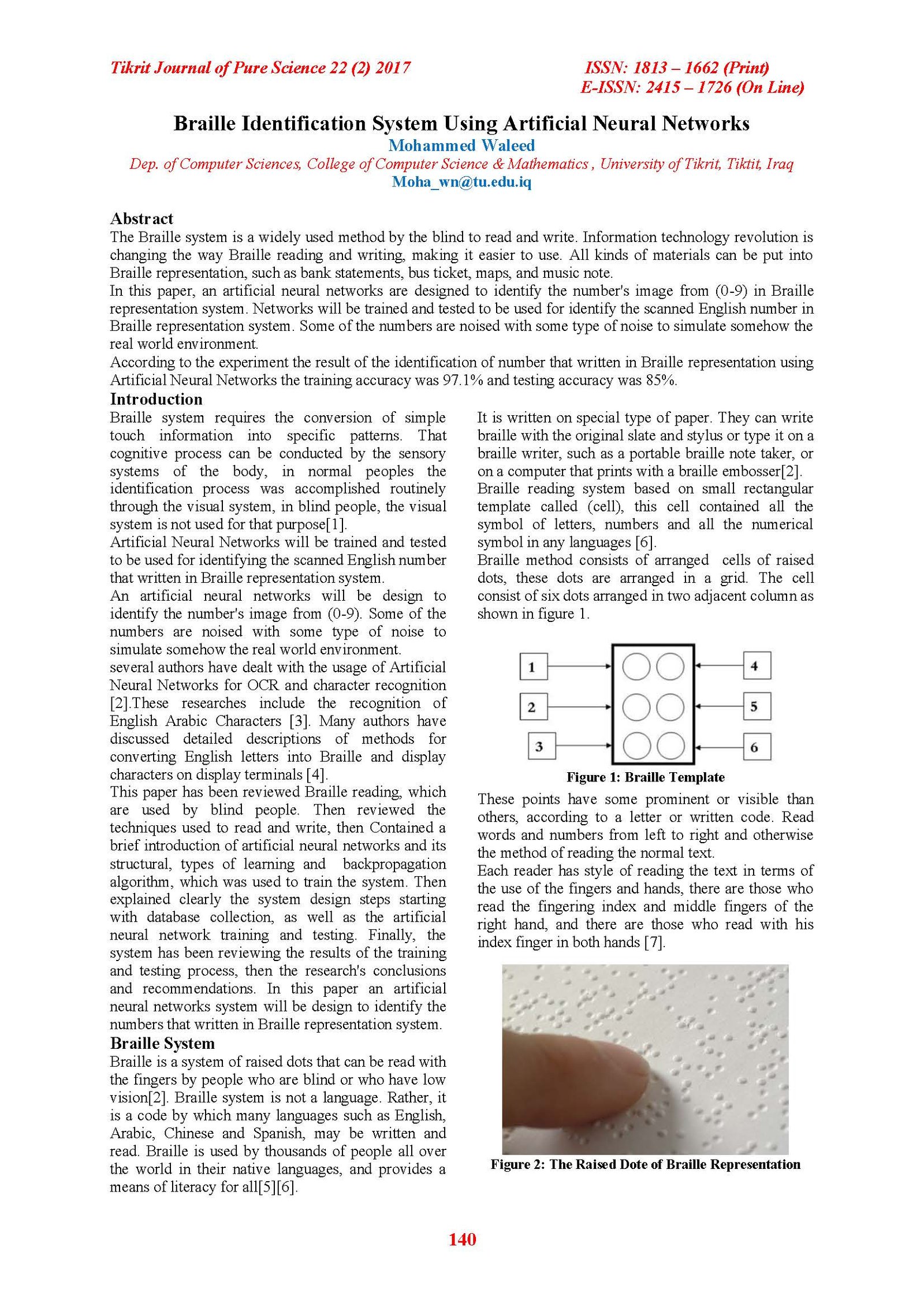Braille Identification System Using Artificial Neural Networks
Main Article Content
Abstract
The Braille system is a widely used method by the blind to read and write. Information technology revolution is changing the way Braille reading and writing, making it easier to use. All kinds of materials can be put into Braille representation, such as bank statements, bus ticket, maps, and music note.
In this paper, an artificial neural networks are designed to identify the number's image from (0-9) in Braille representation system. Networks will be trained and tested to be used for identify the scanned English number in Braille representation system. Some of the numbers are noised with some type of noise to simulate somehow the real world environment.
According to the experiment the result of the identification of number that written in Braille representation using Artificial Neural Networks the training accuracy was 97.1% and testing accuracy was 85%.
Article Details

This work is licensed under a Creative Commons Attribution 4.0 International License.
Tikrit Journal of Pure Science is licensed under the Creative Commons Attribution 4.0 International License, which allows users to copy, create extracts, abstracts, and new works from the article, alter and revise the article, and make commercial use of the article (including reuse and/or resale of the article by commercial entities), provided the user gives appropriate credit (with a link to the formal publication through the relevant DOI), provides a link to the license, indicates if changes were made, and the licensor is not represented as endorsing the use made of the work. The authors hold the copyright for their published work on the Tikrit J. Pure Sci. website, while Tikrit J. Pure Sci. is responsible for appreciate citation of their work, which is released under CC-BY-4.0, enabling the unrestricted use, distribution, and reproduction of an article in any medium, provided that the original work is properly cited.
References
1. Sadato N, Pascual-Leone A, Grafman J, Ibanez V, Deiber MP Dold G, et al. Activation of the primary visual cortex by Braille reading in blind subjects [see comments]. Nature 1996; 380: 526–8. Comment in: Nature 1996; 380: 479–80.
2. Khatatneh K., El Emary I. M. M. and Al- Rifai B., "Probabilistic Artificial Neural Network For Recognizing the Arabic Hand Written Characters", Journal of Computer Science, Vol. 3, No. 12, PP. 881-886, 2006,Rex, E. J., Koenig, A.J., Wormsley, D.P. & Baker, R. L. (1994). Foundations of braille literacy. New York: AFB Press.
3. Shilbayeh N. F. and Iskandarani M. Z., "Effect of Hidden Layer Neurons on the Classification of Optical Character Recognition Typed Arabic Numerals", Journal of Computer Science, Vol. 4, No. 7, PP. 578-584, 2008.
4. Karmakar S., Chatterjee R. P. and Dutta U., " Improvement in quality testing of Braille printer output with Euclidean distance measurement using camera calibration", International Journal of Engineering, Science and Technology Vol. 2, No. 1, pp. 35-48, 2010,.
5. AFB American Foundationfor the BlindExpanding possibilities for people with vision loss http://www.afb.org/info/living-with-vision-loss/braille/what-is-braille/123
6. Friendly M, Franklin PE, Hoffman D, Rubin DC. The Toronto Word Pool: norms for imagery, concreteness, orthographic variables, and grammatical usage for 1,080 words. Behav Res Methods Instrument 1982;14: 375–99.
7. MK Design, 2004, “The Professional Sign Consultancy Service”. www.mkdesign.freeonline. co.uk/Braille.htm
8. B. Lowenfield and G. L. Abel, Methods of Teaching Braille Reading Efficiency of Children in Lower Senior Classes. Birmingham, Research Centre for the Education of the Visually Handicapped, 1977
9. B.F. Holland, 'Speed and Pressure Factors in Braille Reading', Teachers Forum, Vol. 7, September 1934 pp. 13–17
10. Peter A., Burgsteiner H., Maass W.,"A learning rule for very simpleuniversal approximators consisting ofa single layer of perceptrons", Neural Networks, Vol. 21, No. 5, PP. 786–795, 2008.
11. Zurada J. M., Introduction toArtificial Neural Networks, 2ndEdition, India, 1996.
12. An introduction to neural computing. Aleksander, I. and Morton, H. 2nd edition
13. Learning internal representations by error propagation by Rumelhart, Hinton and Williams (1986).
14. Neural Networks: A Comprehensive foundation, Simon S. Haykin, (1999), prentice Hall.
